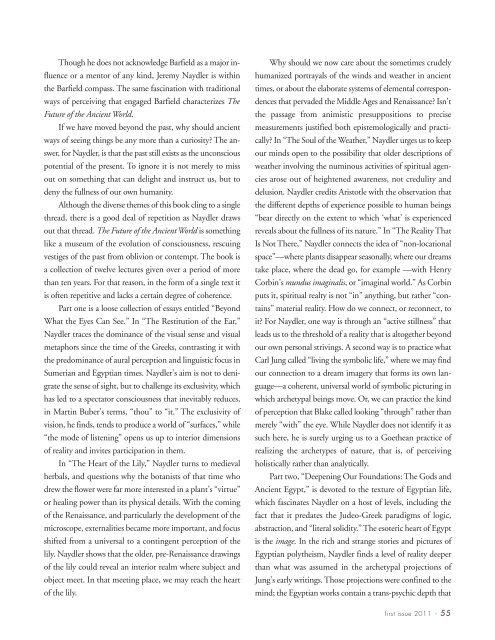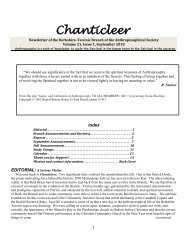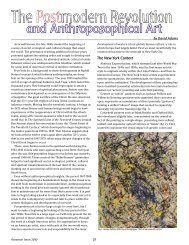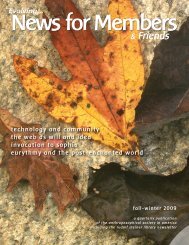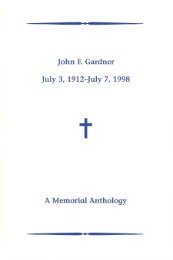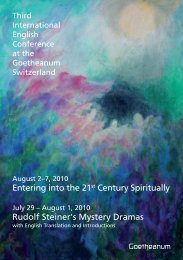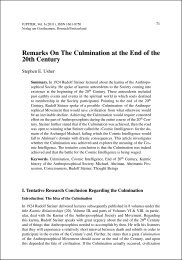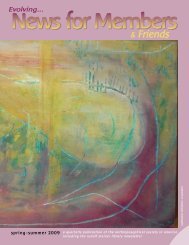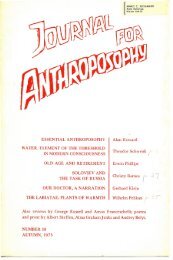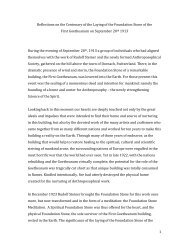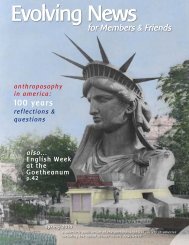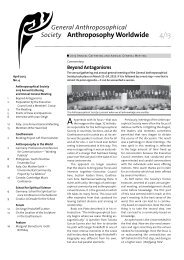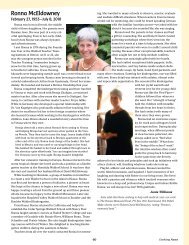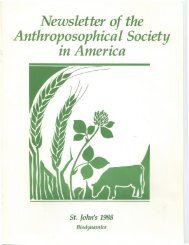Rudolf Steiner's Vision for the Future - Anthroposophical Society in ...
Rudolf Steiner's Vision for the Future - Anthroposophical Society in ...
Rudolf Steiner's Vision for the Future - Anthroposophical Society in ...
You also want an ePaper? Increase the reach of your titles
YUMPU automatically turns print PDFs into web optimized ePapers that Google loves.
Though he does not acknowledge Barfield as a major <strong>in</strong>-<br />
fluence or a mentor of any k<strong>in</strong>d, Jeremy Naydler is with<strong>in</strong><br />
<strong>the</strong> Barfield compass. The same fasc<strong>in</strong>ation with traditional<br />
ways of perceiv<strong>in</strong>g that engaged Barfield characterizes The<br />
<strong>Future</strong> of <strong>the</strong> Ancient World.<br />
If we have moved beyond <strong>the</strong> past, why should ancient<br />
ways of see<strong>in</strong>g th<strong>in</strong>gs be any more than a curiosity? The answer,<br />
<strong>for</strong> Naydler, is that <strong>the</strong> past still exists as <strong>the</strong> unconscious<br />
potential of <strong>the</strong> present. To ignore it is not merely to miss<br />
out on someth<strong>in</strong>g that can delight and <strong>in</strong>struct us, but to<br />
deny <strong>the</strong> fullness of our own humanity.<br />
Although <strong>the</strong> diverse <strong>the</strong>mes of this book cl<strong>in</strong>g to a s<strong>in</strong>gle<br />
thread, <strong>the</strong>re is a good deal of repetition as Naydler draws<br />
out that thread. The <strong>Future</strong> of <strong>the</strong> Ancient World is someth<strong>in</strong>g<br />
like a museum of <strong>the</strong> evolution of consciousness, rescu<strong>in</strong>g<br />
vestiges of <strong>the</strong> past from oblivion or contempt. The book is<br />
a collection of twelve lectures given over a period of more<br />
than ten years. For that reason, <strong>in</strong> <strong>the</strong> <strong>for</strong>m of a s<strong>in</strong>gle text it<br />
is often repetitive and lacks a certa<strong>in</strong> degree of coherence.<br />
Part one is a loose collection of essays entitled “Beyond<br />
What <strong>the</strong> Eyes Can See.” In “The Restitution of <strong>the</strong> Ear,”<br />
Naydler traces <strong>the</strong> dom<strong>in</strong>ance of <strong>the</strong> visual sense and visual<br />
metaphors s<strong>in</strong>ce <strong>the</strong> time of <strong>the</strong> Greeks, contrast<strong>in</strong>g it with<br />
<strong>the</strong> predom<strong>in</strong>ance of aural perception and l<strong>in</strong>guistic focus <strong>in</strong><br />
Sumerian and Egyptian times. Naydler’s aim is not to denigrate<br />
<strong>the</strong> sense of sight, but to challenge its exclusivity, which<br />
has led to a spectator consciousness that <strong>in</strong>evitably reduces,<br />
<strong>in</strong> Mart<strong>in</strong> Buber’s terms, “thou” to “it.” The exclusivity of<br />
vision, he f<strong>in</strong>ds, tends to produce a world of “surfaces,” while<br />
“<strong>the</strong> mode of listen<strong>in</strong>g” opens us up to <strong>in</strong>terior dimensions<br />
of reality and <strong>in</strong>vites participation <strong>in</strong> <strong>the</strong>m.<br />
In “The Heart of <strong>the</strong> Lily,” Naydler turns to medieval<br />
herbals, and questions why <strong>the</strong> botanists of that time who<br />
drew <strong>the</strong> flower were far more <strong>in</strong>terested <strong>in</strong> a plant’s “virtue”<br />
or heal<strong>in</strong>g power than its physical details. With <strong>the</strong> com<strong>in</strong>g<br />
of <strong>the</strong> Renaissance, and particularly <strong>the</strong> development of <strong>the</strong><br />
microscope, externalities became more important, and focus<br />
shifted from a universal to a cont<strong>in</strong>gent perception of <strong>the</strong><br />
lily. Naydler shows that <strong>the</strong> older, pre-Renaissance draw<strong>in</strong>gs<br />
of <strong>the</strong> lily could reveal an <strong>in</strong>terior realm where subject and<br />
object meet. In that meet<strong>in</strong>g place, we may reach <strong>the</strong> heart<br />
of <strong>the</strong> lily.<br />
Why should we now care about <strong>the</strong> sometimes crudely<br />
humanized portrayals of <strong>the</strong> w<strong>in</strong>ds and wea<strong>the</strong>r <strong>in</strong> ancient<br />
times, or about <strong>the</strong> elaborate systems of elemental correspondences<br />
that pervaded <strong>the</strong> Middle Ages and Renaissance? Isn’t<br />
<strong>the</strong> passage from animistic presuppositions to precise<br />
measurements justified both epistemologically and practically?<br />
In “The Soul of <strong>the</strong> Wea<strong>the</strong>r,” Naydler urges us to keep<br />
our m<strong>in</strong>ds open to <strong>the</strong> possibility that older descriptions of<br />
wea<strong>the</strong>r <strong>in</strong>volv<strong>in</strong>g <strong>the</strong> num<strong>in</strong>ous activities of spiritual agencies<br />
arose out of heightened awareness, not credulity and<br />
delusion. Naydler credits Aristotle with <strong>the</strong> observation that<br />
<strong>the</strong> different depths of experience possible to human be<strong>in</strong>gs<br />
“bear directly on <strong>the</strong> extent to which ‘what’ is experienced<br />
reveals about <strong>the</strong> fullness of its nature.” In “The Reality That<br />
Is Not There,” Naydler connects <strong>the</strong> idea of “non-locational<br />
space”—where plants disappear seasonally, where our dreams<br />
take place, where <strong>the</strong> dead go, <strong>for</strong> example —with Henry<br />
Corb<strong>in</strong>’s mundus imag<strong>in</strong>alis, or “imag<strong>in</strong>al world.” As Corb<strong>in</strong><br />
puts it, spiritual realty is not “<strong>in</strong>” anyth<strong>in</strong>g, but ra<strong>the</strong>r “conta<strong>in</strong>s”<br />
material reality. How do we connect, or reconnect, to<br />
it? For Naydler, one way is through an “active stillness” that<br />
leads us to <strong>the</strong> threshold of a reality that is altoge<strong>the</strong>r beyond<br />
our own personal striv<strong>in</strong>gs. A second way is to practice what<br />
Carl Jung called “liv<strong>in</strong>g <strong>the</strong> symbolic life,” where we may f<strong>in</strong>d<br />
our connection to a dream imagery that <strong>for</strong>ms its own language—a<br />
coherent, universal world of symbolic pictur<strong>in</strong>g <strong>in</strong><br />
which archetypal be<strong>in</strong>gs move. Or, we can practice <strong>the</strong> k<strong>in</strong>d<br />
of perception that Blake called look<strong>in</strong>g “through” ra<strong>the</strong>r than<br />
merely “with” <strong>the</strong> eye. While Naydler does not identify it as<br />
such here, he is surely urg<strong>in</strong>g us to a Goe<strong>the</strong>an practice of<br />
realiz<strong>in</strong>g <strong>the</strong> archetypes of nature, that is, of perceiv<strong>in</strong>g<br />
holistically ra<strong>the</strong>r than analytically.<br />
Part two, “Deepen<strong>in</strong>g Our Foundations: The Gods and<br />
Ancient Egypt,” is devoted to <strong>the</strong> texture of Egyptian life,<br />
which fasc<strong>in</strong>ates Naydler on a host of levels, <strong>in</strong>clud<strong>in</strong>g <strong>the</strong><br />
fact that it predates <strong>the</strong> Judeo-Greek paradigms of logic,<br />
abstraction, and “literal solidity.” The esoteric heart of Egypt<br />
is <strong>the</strong> image. In <strong>the</strong> rich and strange stories and pictures of<br />
Egyptian poly<strong>the</strong>ism, Naydler f<strong>in</strong>ds a level of reality deeper<br />
than what was assumed <strong>in</strong> <strong>the</strong> archetypal projections of<br />
Jung’s early writ<strong>in</strong>gs. Those projections were conf<strong>in</strong>ed to <strong>the</strong><br />
m<strong>in</strong>d; <strong>the</strong> Egyptian works conta<strong>in</strong> a trans-psychic depth that<br />
first issue 2011 • 55


